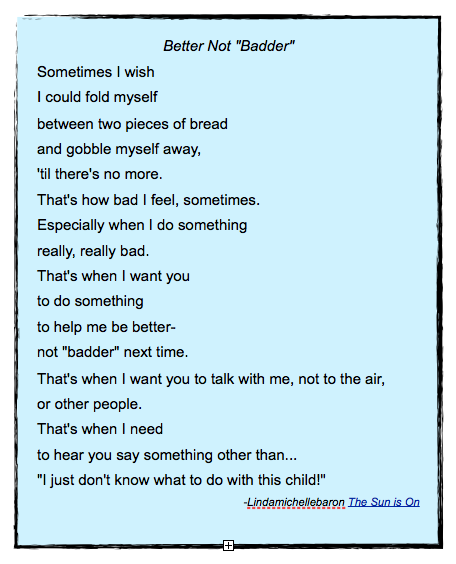
Last year I spent some time throughout the school year snapping photos of student work that was displayed in the hallways and classrooms, creating slideshows using PhotoPeach, and posting “I Spy” tours of our student learning displays on our school websites to share with parents.
I Spy, March 5! on PhotoPeach
I admit that I have not been posting these slideshows regularly this year, and today I made a commitment to do so, because there is so much fantastic learning going on in our school! But then I considered why I didn’t feel as compelled to do this.
It’s not because what I see in the hallways or classrooms is any less enthralling or interesting than it’s been in the past … it’s because more teachers and students are sharing student work and learning themselves! It’s like we’ve all been infected with some sort of wonderful, crazy, addictive sharing disease that is spreading like wildfire throughout our school!
My teachers have grown so much in their willingness to engage students in different types of learning experiences throughout this year. Much of our increased ability to share student work can be attributed to the use of social media and the integration of new tools to enhance student engagement with the content.
Our primary students have created Voicethreads and teamed up with intermediate grade reading buddies to create digital stories with Little Bird Tales. They’re trying Voki, Skyping with virtual pen-pals (check out their visitor map!), and have really been dedicating time to writing on their blogs. We’re sharing our school events with descriptive slideshows.
Intermediate students have been broadening conversations with Today’s Meet, working with Xtranormal, garnering input for math data projects with Google forms, and creating Voicethreads. We’ve jumped into collaborating with Google Docs and students use Glogster to summarize their learning. They’re engaging in conversations with their families and visitors around the world! One of our fifth grade classes created a video tour of our school to share with their Oregon penpals, and some students even participated in our staff Sharing Showcase last week! I’ve seen some very eager Prezi creators, and enjoyed reading these Kidblog reading reflections. Our school “newspaper” has been moved online to help easily share our students’ writing and project work. Parents and teachers can more easily comment on what’s happening!
The benefits of sharing are endless. Parents have a wide open window into classroom happenings. Students are connecting with other teachers and students throughout our country and world. Students are active, engaged, and motivated learners in these experiences. Teachers’ and student excitement is spreading…
Initially, I believe the teachers that felt comfortable risk-taking and trying new ideas with students were hesitant to share their joys about the process, for fear of “bragging” or looking they were trying to out-do their grade level colleagues. Similarly, I think teachers were timid about sharing the struggles they experienced throughout the change, worried that their frustrations might dissuade other teachers from taking risks themselves. We need to overcome this mindset. We need to encourage growth in ourselves and others.
Reading Shelley Wright‘s post this morning, I knew I immediately would share her words with my teachers, because her message to Improvise, Learn, Don’t Regret is one that I want my teachers, and students, to embrace. She has taken the time to document her journey into project-based learning and share that experience with all of us. We have gained insight, perspective, and appreciation for the process because she has done so. This doesn’t happen without honest transparency.
Thank you, Justin, for the challenge to share the wonderful things happening in our schools! We all need to spread the sharing bug… it’s an ailment worth enduring!













